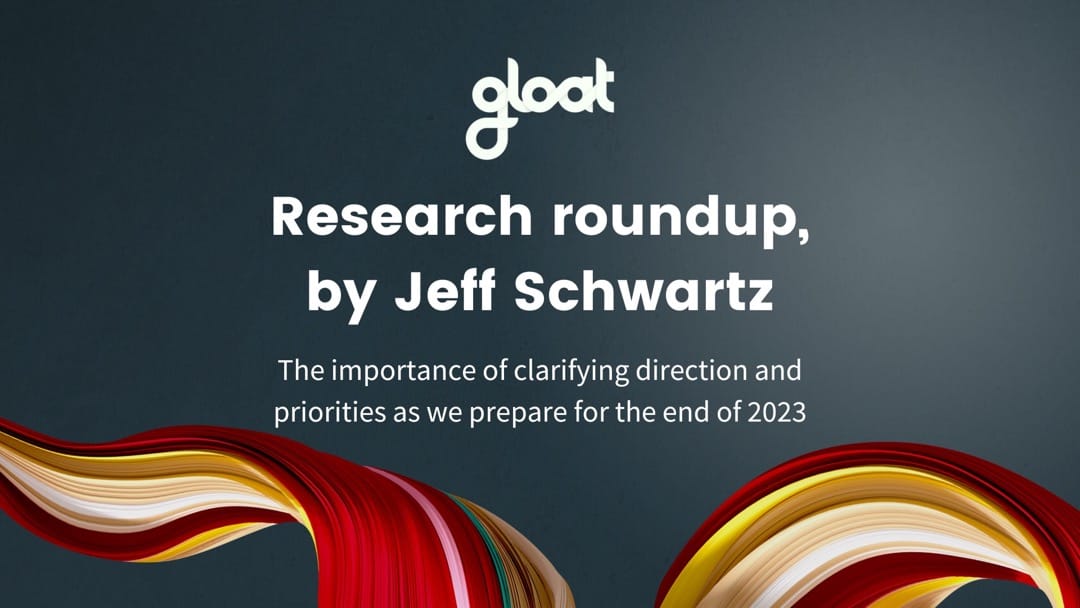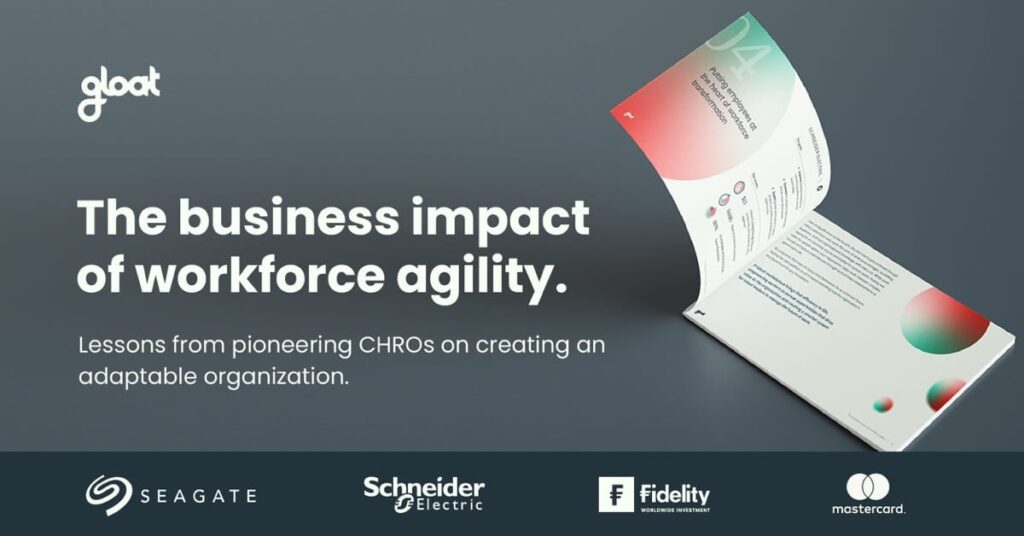Summer research roundup

What I am reading, listening to, and thinking about in the world of talent marketplaces and skills
“If you don’t know where you’re going, any road will get you there.” – Lewis Carroll
It’s September 2023. With just over one quarter of the year to go before 2024, I’m observing that amidst all that is going on this year (and there’s a lot), many talent, HR, people, and business leaders I speak with around the world are all over the map when it comes to clear workforce and talent priorities. Hence, my reflection on Lewis Carroll’s musing above.
Earlier this year I wrote a piece on the three paths forward in 2023 and observed that business and talent leaders are considering three paths forward: “the path back to 2019″—returning to the good old ways of working, the “search for a ‘normal’ year”—yearning for a pause, a time to recover from the burnout of the COVID years (well, that’s unlikely!), and “lean into the future path”—zooming out in 2023 and working backward from the future we want to craft in 2025 and 2030 to zoom in and set priorities today.
In this research roundup for the summer of 2023 (and for my colleagues in the southern hemisphere, the winter!), I’m sharing a variety of pieces that illustrate the range of issues in front of us. And yet, the fundamental challenge is recognizing that 2023 and 2024 are years that require shifts in our thinking and bold moves—and much more than a series of incremental changes with legacy technologies and approaches. In the next few weeks, Gloat and The Josh Bersin company will be releasing our research on the adaptable organization (much more to come on this). Our research uncovers a new model for organizations and workforces in the Post-Industrial era. Mobility, agency, flexibility, and a shift to organizations, people, and work in motion are the underpinnings of what’s next.
As you read this research roundup, think hard about where you see your workforce, talent, people, and work priorities going forward. Where do you want to be, where do you need to be, in 2025 and 2030, and what direction, priorities, and initiatives will get you there?
REFLECT As we transition to the fall of 2023 I’m highlighting a “classic” piece for this roundup.
The War to Develop Talent, Deloitte, by Bill Pelster, Jeff Schwartz, Dave Rizzo, Jaime Valenzuela, and Bernard Van der Vyver: In 2013 when I was the Global Editor of Deloitte Consulting’s Global Human Capital Trends Report, we wrote about The war to develop talent. Yes, a decade ago, we could see that the talent management pendulum was swinging from recruitment to development. The piece identified four drivers: struggling to fill talent gaps, raising the bar on talent development (the importance of growing talent inside organizations), escalating recruiting costs (and the difficulty in finding the talent you most need), and employees seeking lifelong development opportunities and growth. In many ways, the war for talent has evolved into a war to develop talent—from anywhere in your organization, and workforce ecosystems, and to find and grow the skills and leaders you need.
READ What’s new in thought leadership about skills, talent marketplaces, and the future of work
Welcome to the Post-Industrial Economy: AI is Here to Save US, joshbersin.com, by Josh Bersin: At the Irresistible Conference in June, Josh Bersin’s keynote helped us all picture where we are and what’s coming as he described the shift from the Industrial to the Post-Industrial world. As Josh summarizes in this article and an attached video, the future is shaped by a “shortage of workers, obsolescence of skills, and newfound employee autonomy [which] is not a temporary thing: it is a symptom of a new economic era. And we call this new era the “Post-Industrial Age.” Josh will continue to develop this theme this fall and it’s an important framing for planning and setting future priorities (the theme of this research roundup).
The Business Impact of Workforce Agility, gloat.com: This summer our research team at Gloat produced this timely report focusing on the business impact and ROI (return on investment) of talent and career marketplaces and skills analytics—our core platform. What’s unique about this report is that it focuses on the outcomes of workforce agility and talent markets—not features and functions. In charting your path forward, starting with business challenges and a clear view of what meaningful business metrics you want to move are essential.
Examples include millions in savings unlocked through reduced external hiring costs, minimized termination costs and improved retention and redeployment, percentage of full-time roles now filled internally, tens of thousands of hours of productivity unlocked, millions in savings through internal mobility, millions in savings through enhanced productivity, hours unlocked across internal projects and savings through internal gigs, increase cross-functional project collaboration, innovation, R&D, improve redeployment of employees targeted for restructuring, upskilling and reskilling effectively and at speed and scale, and creating an inclusive workforce.
3 Super Human Talents AI Will Not Replace, Harvard Business Review, by Tomas Chamorro-Premuzic and Reece Akthar: In this recent HBR article, researchers Tomas Chamorro-Premuzic and Reece Akthar reflect on three human traits we need to develop as we work next to and with AI and robots. I love their list including: curiosity, humility, and emotional intelligence. Take a look and ask how you and your company are redesigning work to highlight what people and machines can uniquely do and how they can be combined for super teams and productivity.
Return to the Office Enters the Desperation Phase, The New York Times, by Emma Goldberg: This article from Emma Goldberg at the NY Times captures the yin and yang of where we are, and perhaps where we’re going with the great remote and hybrid work experiment. Back and forth. Three days? Two days? Not Monday and Friday? More productive? Less productive? Senior leaders want it? New employees need it? Wait. What are the trends and what are we trying to accomplish here? Is this about putting the genie back in the bottle or designing a new way to think about what work we do and how and where we do it?
WATCH AND LISTEN What I’ve been playing on repeat
AI Could Solve Some of Humanity’s Hardest Problems. It Already Has., The Ezra Klein Show, with Ezra Klein and Demis Hassabis: In the exuberance, noise, and fear generated by AI following the introduction of ChatGPT in the past year, there’s a lot to sort through. This podcast from Ezra Klein includes a detailed interview with Demis Hassabis, the founder and chief executive of Google DeepMind. It’s definitely worth the hour to explore the history of Deepmind, improve your understanding of AI, and the incredible story of Alpha Fold—a detailed case study on how AI can help us solve scientific challenges by combining the computing power of AI and the ingenuity of human researchers.
Working: What We Do All Day, Netflix: This Netflix special series hosted by Barack Obama provides a unique, personal view of work in America from four perspectives: service jobs, the middle, dream jobs, and the boss. The series is inspired by and in the spirit of the work of Studs Terkel’s 1997 book based on oral history Working: People Talk about What They Do All Day and How They Feel About What They Do. For a visual journey into the work people are doing today, this is an engaging way to spend a couple of hours.
Forward Thinking on how to live our longer lives with Andrew J. Scott, McKinsey: A great podcast from McKinsey featuring Andrew J. Scott, professor at London Business School, co-author with Lynda Gratton of the book 100 Year Lives. The podcast provides perspectives on the economic impacts of longevity, the changing nature of careers, and how to focus health and wellness on longer lives. This is a critical frame for 21st-century workforces and work.
Building Robust Workforce Ecosystems in Today’s Digital Era, Velocity Network Foundation: In June at CornellTech’s campus in NYC, I had the opportunity to kick off day two of the annual meeting of Velocity Networks—an amazing organization reinventing how career records are shared across the global market by deploying the Internet of Careers through the blockchain to share career records. It was an opportunity to highlight insights from our recent book, Workforce Ecosystems: Reaching Strategic Goals through People, Partnerships, and Technologies, and the five categories of workforce ecosystem tech including work tech, workforce tech, workplace tech, verification and credentialization tech, and technology as a workforce participant. For a more detailed discussion, listen to the Future Work/Life Podcast with Ollie Henderson and me recorded just before this conference: Workforce Ecosystems with Jeff Schwartz. And finally, a great summary of our book was published in the Sloan Management Review summer issue: Manage your workforce ecosystem, not just your employees.
THINK What research and studies are saying about our path forward
Understanding AI in HR, joshbersin.com, by Josh Bersin: Earlier this summer, Josh Bersin introduced his deep-dive research paper on AI in HR. Both a primer and exploration of how AI is impacting HR, L&D, and all aspects of talent management, the research highlights: the differences between technologies that have AI added on or AI built in vs technology that is completely built on AI, the importance of data to functional AI solutions, along with descriptions of the various databases, and how the kinks in the current systems will get worked out to create more accurate results. Josh continues to provide leading insights into what is happening with AI and its implications for HR and the workforce both broadly and deeply.
The economic potential of generative AI: the next productivity frontier, McKinsey, by Michael Chui, Roger Roberts, Lareina Yee, Eric Hazan, Alex Singla, Kate Smaje, Alex Sukharevsky, and Rodney Zemmel: This special report from McKinsey helps us put dimensions around the impact of generative AI in two broad areas: the economic potential, i.e. the broad organizational use cases of generative AI (i.e. customer operations, marketing and sales, software engineering and R&D) and the labor productivity impacts across detailed work activities performed by the global workforce. For people, talent, workforce and work leaders and designers, this report provides critical strategic thinking for building future skill-based workforces
Generative AI and the future of work in America, McKinsey, by Kweilin Ellingrud, Saurabh Sanghvi, Gurneet Singh Dandona, Anu Madgavkar, Michael Chui, Olivia White, and Paige Hasebe: Also from the McKinsey Global Institute, this July report puts recent workforce impacts during the pandemic and forward-looking insights about 2030 into an actionable framework. The report covers five major themes:
- During the pandemic (2019–22), the US labor market saw 8.6 million occupational shifts, 50 percent more than in the previous three-year period.
- By 2030, activities that account for up to 30 percent of hours currently worked across the US economy could be automated—a trend accelerated by generative AI.
- Federal investment to address climate and infrastructure, as well as structural shifts, will also alter labor demand.
- An additional 12 million occupational transitions may be needed by 2030.
- The United States will need workforce development on a far larger scale as well as more expansive hiring approaches from employers.
Build for the Future, Boston Consulting Group, by Amanda Luther, Dylan Bolden, Saibal Chakraborty, Romain de Laubier, and Jessica Apotheker: The Boston Consulting Group’s research on the dimensions of business success going forward is an excellent place to start and “zoom out” to think about how talent, work, and skills fit into the larger strategic reframing of the 2020s. The six attributes in their research include leadership and purpose, people advantage, agile operating models, innovation-driven culture, data platforms and modernized technology, and embedded AI.
CONNECT What future-fit organizations and leaders are talking about
Introducing Gloat for Microsoft Teams: I have to close this summer research roundup with an announcement and video from my amazing colleagues at Gloat. In September, we are launching the link between Gloat and Microsoft Teams. The goal, of course, is to put our talent and career marketplaces in the flow of work, and what better way than to connect Gloat and Microsoft Teams? This video (take a look, you’ll enjoy it) is a drop-the-mike moment for what employees are looking for and what business and HR leaders are seeking: opportunities, growth, and access to skills, aspirations, and the people to do the work we need to get done.
Let us know what you would add to our list.






